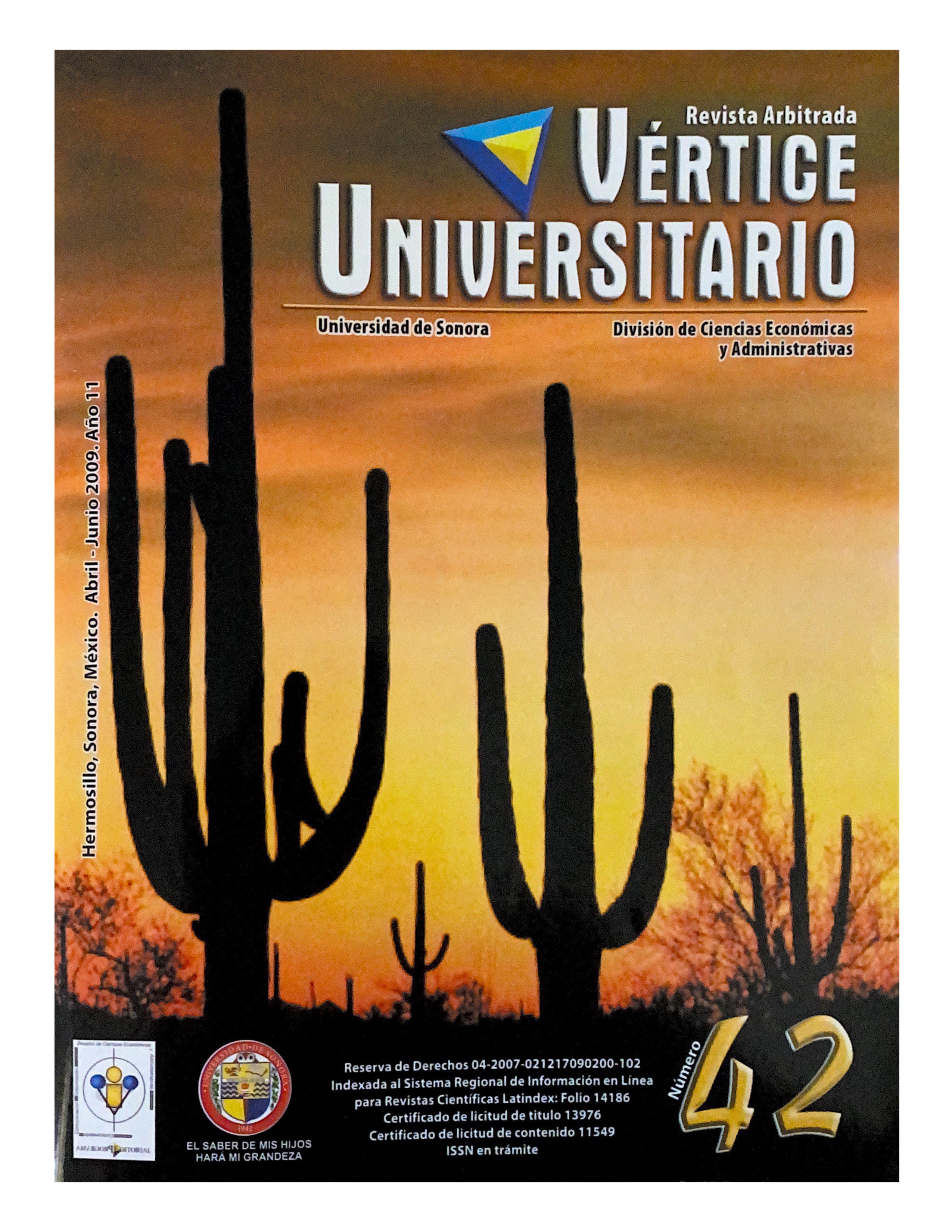Cultural characterization. The small and medium-sized furniture manufacturing company in the city of Durango, Mexico.
A mixed methodological approach
Keywords:
Corporate culture, Characteristics of corporate culture, Cultural pattern in the companyAbstract
The objective of this study is to analyze the characteristics of the culture shared by the members of furniture manufacturing companies in the city of Durango, Mexico, as well as to search for a possible association between the type of company culture and two characteristic variables of the company profile: its permanence over time and the number of years that the manager has been working in the company.
The study used the business culture diagnostic tool proposed by Cameron and Quinn (2006), which distinguishes four types of culture: market, hierarchy, clan and adhocracy. Once the diagnosis was obtained, the statistical analysis revealed a significant relationship between each of the variables considered and hierarchical culture, one of the types of culture found in this study.
Similarly, based on the results of the diagnostic study, the application of Spradley's (1979) ethnographic analysis model is described, which complemented and enriched the quantitative study, helping to better understand the results obtained.
Downloads
References
Alonso-Logroño, M. y Miramontes-Carballada, Á. (2003). La significación de un medio innovador local dentro de la industria de la fabricación de muebles de Galicia, Boletín de la A.G.E. No. 36.
Audretsch D. & Mahmood T., (1995) New firm survival: New results using a hazard function, Review of economics & statistics, Vol. 77 Issue 1, pp. 97-103.
Cameron- Kim S. & Quinn- Robert E. (2006) Diagnosing and Changing Organizational Culture, Ed. Jossey – Bass San Francisco USA.
Dallago, Bruno, (2003) The Importance of Small and Medium Enterprises, U.N. Chronicle No. 4 Ed. United Nations Publications.
Daft R., (1998) Teoría y Diseño Organizacional, (6 edición) Ed. Soluciones empresariales, México.
De la Torre I., (2004) Impacto de la Formación en la Cultura Corporativa y en los Resultados. Estudio aplicado en las entidades del sector Seguros. Universidad Autónoma de Madrid.
Deal Terrence E. & Kennedy Allan A. (2000) Corporate Cultures Ed Perseus Books Publishing. New York. Diario Oficial de la Federación del 30 de diciembre de 2002.
Díez-Gutiérrez E., La Cultura Organizativa Recuperado el 6 de junio del 2006 http://www.unileon.es/dp/odo/ENRIQUE/doctorad/cultura.
Galindo-Calvo P. (2005) La cultura empresarial en Andalucía, Revista PAPERS, 77, pp. 105-133. ISSN 0210-2862.
García-Pérez de Lema (coordinador, 2007) Análisis estratégico para el desarrollo de la pequeña y mediana empresa del estado de Durango, Ed. Universidad Juárez del estado de Durango, Durango México.
Gobierno del estado de Durango (2003), Durango Competitivo 2020, Programa regional de competitividad sistémica. Ed. Talleres de impresión de Gobierno del estado de Durango, México.
Gómez-Romero I., (2004) Como una Institución Genera Conocimiento Organizacional, lo Generaliza en su Comunidad, y Descubre sus Incapacidades de aprendizaje, para alcanzar su Misión y su Visión, Tesis Doctoral, Universidad Autónoma de Aguascalientes.
Hair F., Anderson R., Tatham R., Black W., (2004), Análisis multivariante (5 edición) Ed. Pearson Prentice Hall. España.
Hernández-Sampieri R., Fernández- Collado C., Baptista-Lucio P. (2004). Metodología de la Investigación (tercera edición) México.: Ed. Mc Graw Hill Interamericana de México S.A de C.V.
Hernández-Romo M., (2004). La cultura Empresarial en México. Ed. Porrúa México.
Instituto Nacional de Estadística, Geografía e Informática. Página Web, www.inegi.gob.mx Recuperado el 24 de junio del 2007
Leal-Millán A., Martín-Armario E., Hernández-Mogollón J., (2002) Cultura Organizativa y Orientación al Mercado: Un Análisis Multisectorial en Pymes. Universidad de Extremadura.
Lind D., Marchal W., Wathen S., (2005) Estadística Aplicada a los Negocios y a la Economía. (12ª. Edición) Ed. Mc Graw Hill México.
Linton R., (1965) Cultura y personalidad. Ed. Fondo de Cultura Económica, México Buenos Aires.
Martínez-Herrera P., (2002) El Contexto y la Estructura Organizativa de la Industria Forestal Ejidal del Estado de Durango, Tesis para obtener el grado de Doctor en Administración. Universidad Juárez del Estado de Durango” México.
Palacios-Moncayo M., (2005) Durango: Economía, Sociedad, Política y Cultura. Ed. UJED, LXIII Legislatura del Edo. de Durango, Instituto de la cultura del Edo. de Durango, México.
Quinn R., (2003) Organization Strengths and Culture Action Planning Guide. Eepulse Michigan Business School.
Rodríguez M., Ramírez P., (2004) Psicología del mexicano en el trabajo, México Ed. Mc. Graw Hill.
Schiller H., (1996) Cultura, S.A. La apropiación corporativa de la expresión pública. Universidad de Guadalajara, México.
Secretaria de Economía, recuperado en junio de 2006 http://www.siem.gob.mx/portalsiem/estadisticas/repsector
Spradley, J.P. (1979) The Ethnographic Interview. Ed. Hartcourt College Publishers. Florida, EUA.
Stoica M., Jianwen L., Welsh H., (2004) Organizational Culture and Patterns of Information Processing: The Case of Small and MediumSized Enterprises. Journal of Developmental Entrepreneurship Vol. 9, No. 3
Schwarz, G.C. (1996) Meaning Institutions and Change: An Interpretive approach applied to the case study of a Mexican University. Tesis doctoral Universidad de Texas en Austin, EUA. Thevenet M., (1992) Auditoria de la Cultura Empresarial. Ed. Díaz de Santos, Madrid.
Vargas-Hernández J., (2005) La Culturocracia Organizacional en México. Hitos de Ciencias Económico Administrativas Año 11No. 29, p.3238.
Vilchez-Pérez J., (2004) La Cultura Corporativa Avancemos: Revista de Investigación y Análisis Universidad Cesar Vallejo. Perú pp. 713.
Yusuf A., & Saffu K., (2005) Planning and Performance of Small and Medium Enterprise Operators in a Country in Transition. Journal of Small Business Management 43(4), pp. 480–497.
Published
How to Cite
Issue
Section
License
Copyright (c) 2024

This work is licensed under a Creative Commons Attribution-ShareAlike 4.0 International License.
The opinions expressed by the authors do not strictly reflect the position of the publisher of the publication. This work is under a CC Attribution-ShareAlike 4.0


















